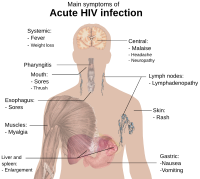
Photo from wikipedia
Time to symptom limitation (Tlim) achieved during constant work rate tests is considerably more responsive to change than measures commonly recorded during ramp‐based tests, such as peak rate of oxygen… Click to show full abstract
Time to symptom limitation (Tlim) achieved during constant work rate tests is considerably more responsive to change than measures commonly recorded during ramp‐based tests, such as peak rate of oxygen uptake and maximal work rate (Wmax). There is limited literature on the use of, and physiological and symptom responses to, constant work rate cycle ergometry tests in people with cystic fibrosis (CF). The results of this study provide evidence that the constant work rate cycle ergometry test, when conducted at 80% of the Wmax, elicits peak physiological and symptom responses and appears to be safe in adults with CF. For clinicians prescribing exercise at an intensity approaching or equivalent to 80% of the Wmax in a non‐laboratory‐based setting, consideration needs to be given to the level of supervision and patient monitoring required.
Journal Title: Internal Medicine Journal
Year Published: 2021
Link to full text (if available)
Share on Social Media: Sign Up to like & get
recommendations!